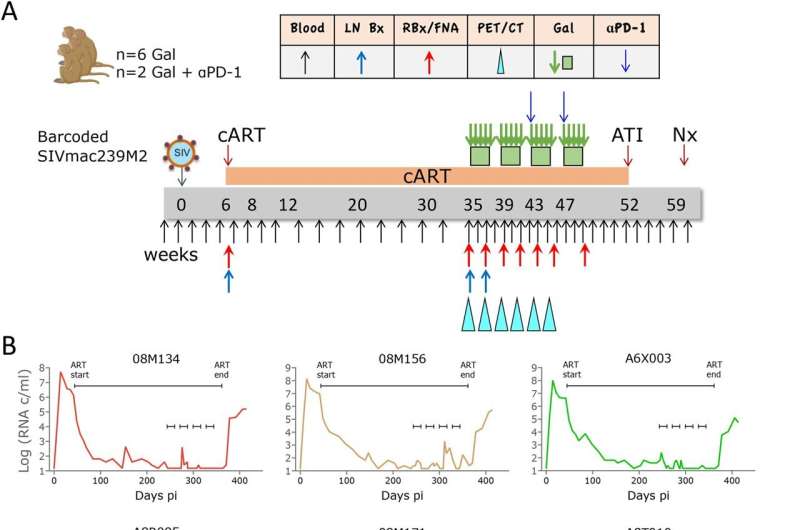This article has been reviewed according to Science X's editorial process and policies. Editors have highlighted the following attributes while ensuring the content's credibility:
fact-checked
trusted source
proofread
Release of inhibitory pathways may promote immune response to HIV

Recent work from the laboratory of Elena Martinelli, Ph.D., MPH, professor of Medicine in the Division of Infectious Diseases and of Microbiology–Immunology, has discovered how inhibiting an immune cell singling pathway in a model of HIV-1 infection may promote immune responses and decrease viral persistence in conjunction with antiretroviral therapy.
The findings, published in Nature Communications, improve the understanding of how HIV-1, the most common type of HIV, can evade and then attack the immune system, and also may inform the development of novel therapeutic strategies against the devastating disease.
An estimated 1.2 million people in the U.S. are currently living with HIV, and the disease disproportionately affects men and Black individuals, according to recent data from the Centers for Disease Control and Prevention.
While this is no cure for HIV, antiretroviral therapy (ART) can help suppress the virus from replicating and infecting immune cells which weaken the patient's immune system, which can help prolong survival and improve quality of life.
Despite the success of the treatment, which must be given over the course of a patient's entire life, HIV infection can persist and evade immune responses through "viral reservoirs," which occur when the virus persists during therapy in immune cells and takes on a latent state.
Previous work from Martinelli's laboratory has investigated the impact of the cytokine TGF-beta on HIV-1 persistence. TGF-beta is released at high levels in patients with HIV-1. Those 2022 findings, published in JCI Insight, found that TGF-beta inhibits HIV reactivation in latently infected immune cells, and suggest that blocking TGF-beta signaling promotes retroviral reactivation and enhances immune responses.
In the current study, Martinelli's team aimed to elucidate the mechanisms promoting HIV-1 viral reservoirs and to better understand the impact of TGF-beta inhibitor drugs on HIV-infected immune cells.
"The strategy we are working toward is using these drugs to basically get the virus to show itself," Martinelli said.
In the current study, the investigators used single-cell RNA sequencing and transcriptomics techniques to study immune cells from nonhuman primate models of simian immunodeficiency virus—a species of retrovirus that causes persistent infections in non-human primates—that were treated with ART and subsequent doses of galunisertib, a TGF-beta inhibitor.
The investigators found this treatment approach promoted HIV-1 viral reactivation and reversed viral latency. They also discovered the approach enhanced immune responses in CD4 T-cells and other immune cells, as well as in the lymph nodes.
"That's the beauty of this strategy: It not only allows for the virus to reveal itself but also boosts the immune response, so the immune cells can kill the viral infected cells, and that's what basically decreases this reservoir," Martinelli said.
The hope, Martinelli said, is that TGF-beta inhibitors could help control HIV-1 viral load in conjunction with ART and eventually allow the patient to go off ART without increasing their risk of disease. In the meantime, Martinelli said more research is needed to understand the true impact on HIV persistence.
"We are now working to better understand these mechanisms with particular attention to what happens in tissue. There has been a lot of work on finding a cure for HIV, but the focus has been on what happens in the blood, just because blood is relatively easy. But with all these techniques we have right now at our disposal, we can really look at the tissue and do larger controlled studies," Martinelli said.
More information: Jinhee Kim et al, TGF-β blockade drives a transitional effector phenotype in T cells reversing SIV latency and decreasing SIV reservoirs in vivo, Nature Communications (2024). DOI: 10.1038/s41467-024-45555-x




















